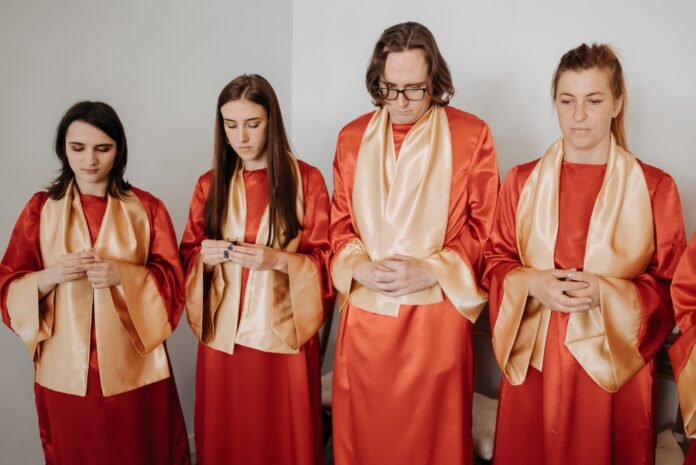Hey there, dear reader! Today, we’re going to dive into the fascinating world of cassocks. No, it’s not a type of cake or an exotic bird, but rather a piece of clothing with a rich history. Cassocks are long, ankle-length garments traditionally worn by clergy members.
They’ve got a distinctive style, and the people who wear them have some interesting stories to tell. So buckle up, and let’s go on a journey through time to explore the world of cassocks!
A Brief History of the Cassock
Before we dive into who wears cassocks and why, let’s take a quick trip back in time to understand where this garment came from. Cassocks have been around for centuries, with their roots tracing back to the ancient Roman Empire. Back then, they were called “tunics” and were worn by both men and women as everyday clothing.
As Christianity spread across the Roman Empire, the tunic evolved into a more formal and distinctive garment for religious leaders. It became the cassock we know today, which is characterized by its long, flowing shape, often with a high collar and a row of buttons down the front. Cassocks were initially made of wool, but as times changed, so did the materials. Today, you can find them made from various fabrics, including polyester and silk blends.
Over the years, the cassock has become a symbol of religious authority and humility. It’s been worn by countless religious leaders, from popes to priests, as a way of distinguishing themselves from the general population. Now that we know a bit about the history let’s dive into the different groups that wear cassocks and why.
Who Wears Cassocks and When?
Cassocks are traditionally worn by members of the clergy, but they’re not just for priests anymore. Here are some of the different groups who wear cassocks and when they might don them:
1. Priests: It’s probably no surprise that priests wear cassocks, given their history. They are often worn during religious services, but also outside of the church as a daily garment. The colour of a priest’s cassock is usually black, symbolizing humility and simplicity.
2. Choir Members: In some churches, members of the choir might also wear cassocks, particularly during formal events or services. Cassocks for choir members are usually black or white, depending on the specific church and its traditions.
3. Altar Servers: Young people who assist during religious services, known as altar servers, might also wear cassocks. In this case, they are often red or black, depending on the church’s customs.
4. Seminarians: Those studying to become priests or seminarians, often wear cassocks as well. This is both a symbol of their dedication to their religious studies and a way to familiarize themselves with the garment they’ll wear once they’re ordained.
5. Bishops, Cardinals, and Popes: Higher-ranking clergy members also wear cassocks, but with a twist. Bishops typically wear a purple cassock, cardinals don a red one, and popes wear a white cassock. These colours signify their rank within the church hierarchy.
Why Do People Wear Cassocks?
Now that we know who wears cassocks and when, let’s explore why this garment has become such an enduring symbol of religious authority.
1. Identity: One of the primary reasons people wear cassocks is to signal their identity as a member of the clergy or a participant in religious ceremonies. The garment acts as a visual cue, helping others recognize their role and responsibilities.
2. Tradition: Cassocks have been worn for centuries,
and as a result, they’ve become deeply ingrained in religious tradition. Many people within the church feel a sense of connection to their predecessors when they wear a cassock, reminding them of the long and storied history of their faith.
3. Humility: The simplicity of the cassock serves as a reminder of the humility that religious leaders should embody. By wearing a garment that lacks extravagance, those in the clergy demonstrate their dedication to a life of service, rather than one of material wealth.
4. Unity: When multiple people wear cassocks within a religious setting, it creates a sense of unity and belonging. This visual harmony can be particularly powerful during ceremonies or services, fostering a strong sense of community among participants.
5. Functionality: Finally, the cassock also has practical benefits. Its long, flowing design provides warmth and modesty, and the garment is often designed with pockets to hold essential items during religious services.
Conclusion
So there you have it, folks! Cassocks are far more than just a piece of clothing – they’re a symbol of religious identity, humility, unity, and tradition that has endured for centuries. From their humble beginnings as Roman tunics to their modern-day incarnations, cassocks have played a significant role in the lives of religious leaders and communities across the world.
Next time you see someone wearing a cassock, take a moment to appreciate the rich history and symbolism behind this unique garment. And who knows? Maybe you’ll find yourself humming a hymn or feeling a little more connected to the world of faith. Thanks for joining us on this journey through the colourful and cosy world of cassocks (ashington-gowns.com check it out!).










